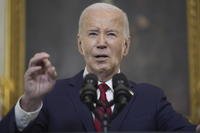The $22.8 billion Marine Corps budget request for Fiscal Year 2015, down $1.4 billion from the previous year, included funding for a major buildup of embassy security and quick reaction forces in the wake of the Benghazi attacks.
Under the proposal, about 1,000 additional Marines would be assigned to Special-Purpose Marine Air-Ground Task Force Crisis Response units and to 12 new Marine embassy security detachments, said Rear Adm. William K. Lescher, who briefed on the Marine and Navy budgets at the Pentagon.
Embassy security has been a major concern of Congress since the 2012 attacks in Benghazi, Libya, that killed Ambassador Chris Stephens and three other Americans.
Marine Corps spokesmen said the $22.8 budget request did not include the Marines’ share from the so-called Overseas Contingency Operations (OCO) fund -- mainly for the war in Afghanistan -- which could boost overall Marine spending to about $30 billion.
Pentagon Comptroller Bob Hale said the OCO fund request, which was in the range of about $85 billion last year, had yet to be drawn up for FY2015 but was likely to amount to a “placeholder” sum of about $79 billion.
The projected extra money for the Marines would “absolutely” be used for the transport and refitting of equipment from Afghanistan, Lescher said.
The $22.8 billion for the Marines was part of the Navy’s overall $148 billion budget request included in the Defense Department’s $495.6 billion Fiscal Year 2015 budget proposal – which itself was part of President Obama’s overall federal spending plan of nearly $4 trillion.
The $1.4 billion reduction for the Marines primarily reflected cuts in the active duty and Reserve forces.
Currently, Marine active duty strength was about 190,000 and was expected to go down to about 182,700 at the end of FY 2015, Lescher said.
If the mandatory cuts under the Congressional sequester process continued, the number of active duty Marines would go down to 179,400 in FY 2016 and 175,000 in FY 2017, Lescher said.
Marine Reserve strength would go down from the current 39,600 to 39,200 at the end of FY2015, according to the projections.
The projected cuts could also force changes in the areas in where Marines are deployed, Lescher said. Currently, about 6,000 Marines are in Afghanistan, 4,600 are aboard ships and 25,300 are deployed to the Pacific region, mainly on Okinawa.
However, the Navy’s overview of the budget stated that the proposed rebalance of U.S. forces to the Pacific would be protected. “Funds will also support a geographically distributed force posture in the Asia-Pacific, which will be increasingly important as U.S. forces are rebalanced to that region,” the overview said.
The Marine budget would maintain purchases of the MV-22 Osprey at 19 in FY2015. The projections were that the Marines would ask for 19 more Ospreys in FY2016 and 18 in FY2017 before dialing back to four Ospreys in FY2018 and four in FY2019.
For new systems, the Marines put a premium on air defense in the budget request. The Marines asked for funding for 89 of Northrup Grumman’s new mobile radar system called the “Gator,” for AN/TPS-80 Ground/Air Task Oriented Radar.








